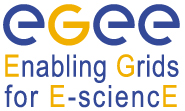Speaker
Describe the added value of the grid for your activity, or the value your tool or service adds for other grid users. This should include the scale of the activity and of the potential user community, and the relevance for other scientific or business applications.
The separation of resource provisioning, managed by OpenNebula, from job execution, managed by existing LRMs, provides the following benefits:
-Cluster consolidation because multiple virtual working nodes can run on a single physical resource, reducing the number of physical systems and so space, administration, power and cooling requirements. The allocation of physical resources to virtual nodes could be dynamic, depending on its computing demands, by leveraging the migration functionality provided by existing VMMs
-
Cluster partitioning because the physical resources of a cluster could be used to execute working nodes bound to different virtual clusters
-
Support for heterogeneous workloads with multiple (even conflicting) software requirements, allowing the execution of software with strict requirements as jobs that will only run with a specific version of a library or legacy application execution
The potential users are the Grid site administrator.
Report on the impact of the activity, tool or service. This should include a description of how grid technology enabled or enhanced the result, or how you have enabled or enhanced the infrastructure for other users.
This approach provides the flexibility required to allow Grid sites to execute on-demand VO-specific working nodes and to isolate and partition the physical resources. Additionally, the architecture offers other benefits to the administrator of the cluster, such as high availability, support for planned maintenance and changing capacity availability, performance partitioning, protection against malicious use of resources…
The new technology helps to overcome current obstacles for Grid adoption:
-
Heterogeneous configuration demands. Users often require specific versions of software components (operating system, libraries or post-processing utilities). The cost of the installation, configuration and maintenance of user-specific or VO-specific worker nodes limits the flexibility of the infrastructure.
-
Performance partitioning. Most of the computing infrastructures do not allow administrators to isolate and partition the performance of the physical resources they devote to the Grid.
Describe the activity, tool or service using or enhancing the EGEE infrastructure or results. A high-level description is needed here (Neither a detailed specialist report nor a list of references is required).
OpenNebula transforms a physical infrastructure into a virtual infrastructure by dynamically overlaying VMs over physical resources. So computing services, such as working nodes managed by existing LRMs (Local Resource Managers) like SGE, OpenPBS..., could be executed on top of the virtual infrastructure; so allowing a physical cluster to dynamically execute multiple virtual clusters.
Abstracts for online demonstrations must provide a summary of the demo content. Places for demos are limited and this summary will be used as part of the selection procedure. Please include the visual impact of the demo and highlight any specific requirements (e.g. network connection). In general, a successful demo is expected to have some supporting material (poster) and be capable of running on a single screen or projector.
The demo will show how to deploy on-demand virtual working nodes with VO-specific configurations. We will require network connection and we will prepare supporting material.




